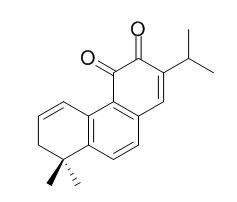Dehydromiltirone
Dehydromiltirone has antioxidant activity, it shows significant anti-neuroinflammatory effects through inhibiting PI3K/Akt phosphorylation and then inhibiting NF-κB signaling pathway.
Inquire / Order:
manager@chemfaces.com
Technical Inquiries:
service@chemfaces.com
Tel:
+86-27-84237783
Fax:
+86-27-84254680
Address:
1 Building, No. 83, CheCheng Rd., Wuhan Economic and Technological Development Zone, Wuhan, Hubei 430056, PRC
Providing storage is as stated on the product vial and the vial is kept tightly sealed, the product can be stored for up to
24 months(2-8C).
Wherever possible, you should prepare and use solutions on the same day. However, if you need to make up stock solutions in advance, we recommend that you store the solution as aliquots in tightly sealed vials at -20C. Generally, these will be useable for up to two weeks. Before use, and prior to opening the vial we recommend that you allow your product to equilibrate to room temperature for at least 1 hour.
Need more advice on solubility, usage and handling? Please email to: service@chemfaces.com
The packaging of the product may have turned upside down during transportation, resulting in the natural compounds adhering to the neck or cap of the vial. take the vial out of its packaging and gently shake to let the compounds fall to the bottom of the vial. for liquid products, centrifuge at 200-500 RPM to gather the liquid at the bottom of the vial. try to avoid loss or contamination during handling.
Food Chem.2019, 279:80-87
PLoS One.2018, 13(3):e0193386
Int J Mol Sci.2021, 22(10):5181.
J Appl Biol Chem2022, 65:343−348.
Malaysian Journal of Analytical Sciences2023, 27(4):840-848.
J Agric Food Chem.2020, 68(51):15164-15175
RSC Adv.2024, 14(40):29319-29329.
Nutrients.2023, 15(12):2644.
J Pharm Biomed Anal.2016, 129:50-59
Molecules.2022, 27(7):2093.
Related and Featured Products
Pharm Biol. 2014 Oct;52(10):1278-85.
Salvia miltiorrhiza compounds protect the liver from acute injury by regulation of p38 and NFκB signaling in Kupffer cells.[Pubmed:
25026357]
Salvia miltiorrhiza Bunge is a traditional Asian medicine used to treat cerebral and cardiac ischemia. However, the effects of the active compounds of S. miltiorrhiza on liver damage are unclear.
In this study, we tested the effects on acute liver injury of crude S. miltiorrhiza extracts from roots as well as neotanshinone B, Dehydromiltirone, tanshinol A, tanshinone I, dihydrotanshinono I, neotanshinone A, cryptanshinono, tanshinone II A, and salvianolie acid B from purified S. miltiorrhiza extracts.
METHODS AND RESULTS:
Various compounds or ethanol extract of S. miltiorrhiza (50, 100, and 200 mg/kg, p.o.) were administered to rats for five consecutive days. After acute carbon tetrachloride (CCl4)-induced liver injury by treatment of rats with a single dose of CCl4 (0.75 mL/kg, p.o), rat liver function was tested by measuring serum biochemical parameters. Serum cytokine concentrations were assessed by enzyme-linked immunosorbent assay (ELISA). Expression of p38 and NFκB was evaluated by western blot.
All S. miltiorrhiza components showed their effects on liver function from the dose from 50 to 200 mg/kg. At the dose of 200 mg/kg, they reduced serum levels of alkaline phosphatase (ALP) by 34-77%, alanine aminotransferase (ALT) by 30-57%, aspartate aminotransferase (AST) by 43-72%, creatine total bilirubin (BIL-T) by 33-81%, albumin (ALB) by 37-67%, indicating that S. miltiorrhiza extracts protected liver from CCl4-induced damage. Moreover, S. miltiorrhiza extracts at 200 mg/kg reduced the increase in the proinflammatory cytokines tumor necrosis factor-α (TNF-α) by 25-82%, interleukin-1 (IL-1) by 42-74% and interleukin-6 (IL-6) by 67-83%, indicating an effect on alleviating liver inflammation. Furthermore, in vitro, S. miltiorrhiza extracts inhibited p38 and NFκB signaling in Kupffer cells. This effect could be a main mechanism by which S. miltiorrhiza protects against acute liver toxicity.
CONCLUSIONS:
Active compounds of S. miltiorrhiza protected the liver from CCl4-induced injury. Protection might have been due to inhibition of p38 and NFκB signaling in Kupffer cells, which subsequently reduced inflammation in the liver.
Chinese Pharmacological Bulletin, 2016(2):177-83.
The anti-neuroinflammatory effects of dehydromiltirone and related mechanisms.[Reference:
WebLink]
To investigate the anti-neuroinflammatory activities of Dehydromiltirone and the underlying mechanisms in LPS-stimulated microglial cell line BV2 cells.
METHODS AND RESULTS:
BV2 cells were pre-treated with Dehydromiltirone,then stimulated by LPS.The levels of nitric oxide(NO) were measured by Griess assay,and the concentrations of pro-inflammatory cytokines were measured by ELISA assay.Confocal fluorescence microscopy was used to measure the expression of MAC-1,the biomarker of activated BV2 cells.The levels of—inducible nitric oxide synthase(iNOS),cyclooxygenase-2(COX-2),NF-κB and PI3K/Akt were determined by Western blot analysis.The treatment of Dehydromiltirone significantly inhibited the production of NO,TNF-α and IL-6,attenuated the expression of iNOS and COX-2 protein,and dampened the microglial activation in LPS-stimulated BV2 cells.The mechanistic study revealed that Dehydromiltirone inhibited the phosphorylation of PI3 K and Akt in LPSstimulated BV2 cells,and decreased NF-κB activation by suppressing the degradation of IκB.
CONCLUSIONS:
Dehydromiltirone shows significant anti-neuroinflammatory effects through inhibiting PI3K/Akt phosphorylation and then inhibiting NF-κB signaling pathway.
Journal of Yantai University, 2000, 13(3):176-80.
Structural Features and Antioxidative Activities on Miltirones.[Reference:
WebLink]
METHODS AND RESULTS:
The antioxidation of miltirone I, Dehydromiltirone and miltirone in fat and the relationship between the structures and antioxidative activities of the three tanshinones are studied by quantum chemical calculation. The results show that the formation of stable complexradical AH R· between the antioxidant AH and the carbon-centred radical R· in fat may be a main mechanism of the antioxidation of quinones antioxidant to retard lipid rancid. Thestabilization energies of the complex radical (CRSE) can keep with the relative trend of induction periods determined. The chemical activity of AH and the stability of AH R· have animportant effect on the antioxidation.
CONCLUSIONS:
Theatomic spin populations and the atomic free valencein AH R· are two valuable parameters of electronic structure with respect to the relative activity of antioxidants.



